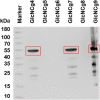Metabolic Engineering of Corynebacterium glutamicum for Production of UDP-N-Acetylglucosamine
- PMID: 34631687
- PMCID: PMC8495162
- DOI: 10.3389/fbioe.2021.748510
Metabolic Engineering of Corynebacterium glutamicum for Production of UDP-N-Acetylglucosamine
Abstract
Uridine diphosphate-N-acetylglucosamine (UDP-GlcNAc) is an acetylated amino sugar nucleotide that naturally serves as precursor in bacterial cell wall synthesis and is involved in prokaryotic and eukaryotic glycosylation reactions. UDP-GlcNAc finds application in various fields including the production of oligosaccharides and glycoproteins with therapeutic benefits. At present, nucleotide sugars are produced either chemically or in vitro by enzyme cascades. However, chemical synthesis is complex and non-economical, and in vitro synthesis requires costly substrates and often purified enzymes. A promising alternative is the microbial production of nucleotide sugars from cheap substrates. In this study, we aimed to engineer the non-pathogenic, Gram-positive soil bacterium Corynebacterium glutamicum as a host for UDP-GlcNAc production. The native glmS, glmU, and glmM genes and glmM of Escherichia coli, encoding the enzymes for UDP-GlcNAc synthesis from fructose-6-phosphate, were over-expressed in different combinations and from different plasmids in C. glutamicum GRS43, which lacks the glucosamine-6-phosphate deaminase gene (nagB) for glucosamine degradation. Over-expression of glmS, glmU and glmM, encoding glucosamine-6-phosphate synthase, the bifunctional glucosamine-1-phosphate acetyltransferase/N-acetyl glucosamine-1-phosphate uridyltransferase and phosphoglucosamine mutase, respectively, was confirmed using activity assays or immunoblot analysis. While the reference strain C. glutamicum GlcNCg1 with an empty plasmid in the exponential growth phase contained intracellularly only about 0.25 mM UDP-GlcNAc, the best engineered strain GlcNCg4 accumulated about 14 mM UDP-GlcNAc. The extracellular UDP-GlcNAc concentrations in the exponential growth phase did not exceed 2 mg/L. In the stationary phase, about 60 mg UDP-GlcNAc/L was observed extracellularly with strain GlcNCg4, indicating the potential of C. glutamicum to produce and to release the activated sugar into the culture medium. To our knowledge, the observed UDP-GlcNAc levels are the highest obtained with microbial hosts, emphasizing the potential of C. glutamicum as a suitable platform for activated sugar production.
Keywords: Corynebacterium glutamicum; UDP-N-acetylglucosamine; activated amino sugars; metabolic engineering; sugar nucleotide.
Copyright © 2021 Gauttam, Desiderato, Radoš, Link, Seibold and Eikmanns.
Conflict of interest statement
The authors declare that the research was conducted in the absence of any commercial or financial relationships that could be construed as a potential conflict of interest.
Figures




Similar articles
-
Metabolic engineering of Lactobacillus casei for production of UDP-N-acetylglucosamine.Biotechnol Bioeng. 2012 Jul;109(7):1704-12. doi: 10.1002/bit.24475. Epub 2012 Mar 2. Biotechnol Bioeng. 2012. PMID: 22383248
-
Regulatory insights into the production of UDP-N-acetylglucosamine by Lactobacillus casei.Bioengineered. 2012 Nov-Dec;3(6):339-42. doi: 10.4161/bioe.21271. Epub 2012 Jul 24. Bioengineered. 2012. PMID: 22825354 Free PMC article.
-
Identification of a Direct Biosynthetic Pathway for UDP-N-Acetylgalactosamine from Glucosamine-6-Phosphate in Thermophilic Crenarchaeon Sulfolobus tokodaii.J Bacteriol. 2018 Apr 24;200(10):e00048-18. doi: 10.1128/JB.00048-18. Print 2018 May 15. J Bacteriol. 2018. PMID: 29507091 Free PMC article.
-
Prospective bacterial and fungal sources of hyaluronic acid: A review.Comput Struct Biotechnol J. 2022 Nov 10;20:6214-6236. doi: 10.1016/j.csbj.2022.11.013. eCollection 2022. Comput Struct Biotechnol J. 2022. PMID: 36420162 Free PMC article. Review.
-
Insights into the central role of N-acetyl-glucosamine-1-phosphate uridyltransferase (GlmU) in peptidoglycan metabolism and its potential as a therapeutic target.Biochem J. 2023 Jun 18;480(15):1147-1164. doi: 10.1042/BCJ20230173. Biochem J. 2023. PMID: 37498748 Review.
Cited by
-
N-Glucosylation in Corynebacterium glutamicum with YdhE from Bacillus lichenformis.Molecules. 2022 May 25;27(11):3405. doi: 10.3390/molecules27113405. Molecules. 2022. PMID: 35684346 Free PMC article.
-
Biosynthesis of Apigenin Glucosides in Engineered Corynebacterium glutamicum.J Microbiol Biotechnol. 2024 May 28;34(5):1154-1163. doi: 10.4014/jmb.2401.01017. Epub 2024 Mar 14. J Microbiol Biotechnol. 2024. PMID: 38563097 Free PMC article.
-
Characterization and Heterologous Expression of UDP-Glucose 4-Epimerase From a Hericium erinaceus Mutant with High Polysaccharide Production.Front Bioeng Biotechnol. 2021 Nov 25;9:796278. doi: 10.3389/fbioe.2021.796278. eCollection 2021. Front Bioeng Biotechnol. 2021. PMID: 34900974 Free PMC article.
-
Glucosylation of Isoeugenol and Monoterpenes in Corynebacterium glutamicum by YdhE from Bacillus lichenformis.Molecules. 2023 Apr 28;28(9):3789. doi: 10.3390/molecules28093789. Molecules. 2023. PMID: 37175199 Free PMC article.
-
Comparison of freeze-thaw and sonication cycle-based methods for extracting AMR-associated metabolites from Staphylococcus aureus.Front Microbiol. 2023 Apr 27;14:1152162. doi: 10.3389/fmicb.2023.1152162. eCollection 2023. Front Microbiol. 2023. PMID: 37180233 Free PMC article.
References
LinkOut - more resources
Full Text Sources

